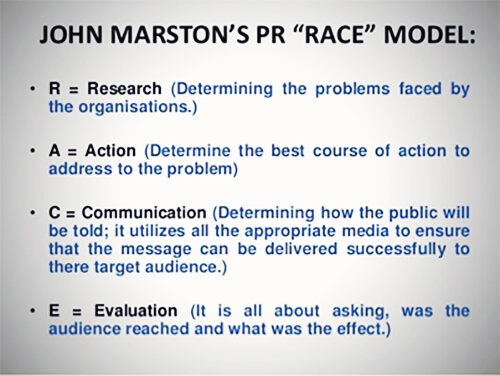
The qualitative method of research has this stigma of being “soft” data.
Some PR experts tend to think of it as unreliable due to the fact that the information is presented in words (scripts, audio, and video recording of the interviews) rather than numbers.
Don’t jump to conclusions if you’re a fan of quantitative methods—where numbers are the solid back up.
Based on public opinion, the qualitative method of research is subjective, but valid if you choose the right audience for observation and interviews.
Keep in mind that the more information you gather, the stronger your strategy becomes.
What feeds the strategy?
The more information you obtain from the research, the better your results!
Here’s a guide to qualitative research.
What Do You Need Before Starting the Qualitative Research?
The preparation stage is defining the topic of study.
It’s back-to-basics, using John Marston’s PR “RACE” Model.
 (Source: Anuj Chaudhary)
(Source: Anuj Chaudhary)
…but the research process also has stages:
- Importance of research
- Primary and secondary research
- Qualitative and quantitative research
- Questionnaire construction
(Source: Barbara Nixon )
Don’t jump straight to the third bullet without precisely defining the subject.
Do the ground work.
Consider the weak sides, and include those in the research to show the solution and remedy.
Before starting the qualitative research, your subject has to be feasible and outlined.
It might change the shape and presentation after the research, but the subject has to maintain integrity all the way through.
Choose Your Approach
Use the approach to establish a connection with the target audience in order to get their opinion, observe their behavior and tendencies, and then study them in-depth.
These methods include, but are not limited to:
- Observations
- Interviewing
- Focus groups
With observations, begin with an online search for feedback on the topic.
Observe attitudes, behaviors, and tendencies towards the issue.
When working with public focus groups, you’ll probably start off with questions such as:
- What comes to mind when you hear the issue/topic?
- What do you know about it?
- What’s your opinion about the issue?
- How do you relate to the issue?
This information should outline variables such as related experiences, interconnected activities, beliefs, and values—the so-called contextual knowledge of the targeted public.
Retain a natural environment where the targeted group may come across your subject of interest.
Make Sure Everyone Gets Their “Piece of Pie”
Take a close look at your team and determine the perfect task for each team member.
When assigning the task, remember the researcher is going to be engaging closely with the informants and guiding the collaborative dialogue.
The tasks for interviewers or the observers are:
- Describe variations among the groups
- Outline the individual experiences and group standards.
- Show the relationships and explain them.
- Keep close to the exact words and formulations of those interviewed—have a tape recorder, a camera, and take notes.
Accessing the Information: Outcome
A large part of the job at this stage is the interpretation of the collected data:
- Divide the responses into categories.
- Find the patterns and support them with direct quotes.
You may consider the qualitative research complete once you have the subjective and detailed descriptions, which will give you a perspective on the behavior of the public.
This is the base for further quantitative research, should you wish to do further research, or the base that defines the shape and guides your strategy.
What have you learned as a pro?
That research rules.
It will make your campaign viable, shield you from failure, and help prevent future failure.
If you want to be strategic, you need to get the research done.
Working in public relations, you’ll make the decisions.
And those decisions had better be the informed ones.
image credit: shutterstock